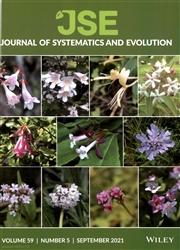南锥体地区禾本科植物的空间系统发生学为南美洲禾本科植物的生态学和进化提供了启示
IF 2.9
1区 生物学
Q1 Agricultural and Biological Sciences
引用次数: 0
摘要
在这项研究中,我们应用几种系统发育多样性(PD)指标和随机化检验,探索了南美洲南锥体(SC)地区草属的分布情况。禾本科植物似乎自 60 多万年前作为热带林下物种早期演化以来就一直存在于南美洲。在进化过程中,禾本科植物适应了所有陆地生物群落,成为地球上最成功的植物科之一。目前,南极洲几乎包含了所有的陆地生物群落以及从湿润到干旱的各种生态区。通过分析 148 个属(占本地禾本科属的 91%)的 126.514 个点出现和 4 个质体标记,我们发现热带潮湿地区的禾本科属的 PD 最高,而且分支长度没有观察到偏差。这些结果表明,生态位保守性主导了南亚地区草类的多样性模式。我们在干查科和巴塔哥尼亚大草原发现了明显较低的PD,这表明在温暖和寒冷干旱地区都存在生态过滤。巴塔哥尼亚大草原的禾本科禾本科植物主要由起源于北半球的远缘禾本科属植物组成,因此该地区的禾本科禾本科植物的分枝也明显比预期的要长。乌拉圭热带草原的分支较短,这表明这些草原可能是南极洲草类多样性的摇篮。年代系统发育支持目前的观点,即该科属在南美洲的演化相对较新,大部分的多样化发生在中新世中期及以后。本文章由计算机程序翻译,如有差异,请以英文原文为准。

Spatial phylogenetics of grasses in the Southern Cone provides insights into ecology and evolution of the family in South America
In this study, we explored the distributions of grass genera in the Southern Cone (SC) of South America, applying several phylogenetic diversity (PD) metrics and randomization tests. Grasses appear to have been present in South America since their early evolution as tropical understory species more than 60 Ma. During the course of evolution, grasses have adapted to all terrestrial biomes and become one of the most successful plant families on earth. At present, the SC contains nearly all terrestrial biomes and a wide range of humid to arid ecoregions. Analyzing 126.514 point occurrences and four plastid markers for 148 genera (91% of the native grass genera), we found that tropical humid regions hold the highest PD, with no observed bias in branch lengths. These results indicate that niche conservatism dominates the diversity pattern of grasses in the SC. We found significantly low PD in the Dry Chaco and in the Patagonian Steppe, which suggest ecological filtering in both warm and cold arid regions. The Patagonian Steppe also holds significantly longer branches than expected by chance, as the native grass flora is mainly composed of distantly related Pooideae genera with a northern hemisphere origin. Short branches are found in the Uruguayan Savanna, suggesting that these grasslands could be a cradle for grass diversity within the SC. The dated phylogeny supported the current view of a relatively recent evolution of the family within the SC, with most diversification taking place from the middle Miocene and onwards.
求助全文
通过发布文献求助,成功后即可免费获取论文全文。
去求助
来源期刊

Journal of Systematics and Evolution
Agricultural and Biological Sciences-Ecology, Evolution, Behavior and Systematics
CiteScore
7.40
自引率
8.10%
发文量
1368
审稿时长
6-12 weeks
期刊介绍:
Journal of Systematics and Evolution (JSE, since 2008; formerly Acta Phytotaxonomica Sinica) is a plant-based international journal newly dedicated to the description and understanding of the biological diversity. It covers: description of new taxa, monographic revision, phylogenetics, molecular evolution and genome evolution, evolutionary developmental biology, evolutionary ecology, population biology, conservation biology, biogeography, paleobiology, evolutionary theories, and related subjects.
 求助内容:
求助内容: 应助结果提醒方式:
应助结果提醒方式:


